Memorial Day was a day set apart to honor the dead of the Civil War; and so TOF thought it fitting to mention a veteran of that war, one who is most assuredly at this point dead, and began writing this piece on Memorial Day. But the bare bones was not enough. It was not enough to cite his unit or to mention his wound, but the narrative demanded to know how the heck he got there and where was he running around before and after?
That led inter alia to the fortuitous discovery of the orderings and postings of the 5th Tenn, USV, the reports of the Adjutant General of Tennessee, various orders of battle, and TOF pulling out his West Point Atlas of American Wars that had once graced Military History 101 back in Old College Days. All told, it delayed matters in the usual TOFian way and the narrative has grown with the chewing like goat barbecue.
His task then became cutting it down. After all, this post was never intended to be a blow-by-blow account of the Central Theater of the War.
But let us commence...
John H. Hammontree, grandfather of a grandfather of the Incomparable One, was born ca. 1843 near Morganton, which was then in Blount County, Tennessee, It was situated southwest of Maryville on the Little Tennessee.
Blount County was larger then (see map). It lay north of the Little Tennessee and nestled against the foot of Smokey Mountain (a/k/a Iron Mountain, now known as the Great Smokey Mountains).
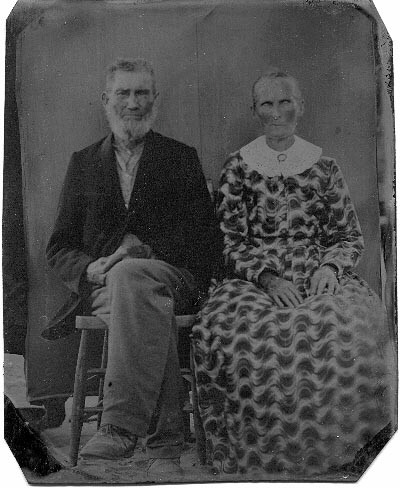 |
| Edom
Hammontree (1817-1900+) & Martha Jane Smith. He was a son of
William Hammontree, so some sort of great grand uncle to John. He eventually wound up in Arkansas. |
The relatively flat land here is part of a valley carved by Baker Creek, a tributary of the Little Tennessee River. Chilhowee Mountain and the Great Smoky Mountains are visible to the south. Today Morganton lies in Loudon Co., which was created in 1870. Or it would so lie if the site of former Morganton had not vanished under the waters of the Tellico Dam, along with the fabled snail darter.
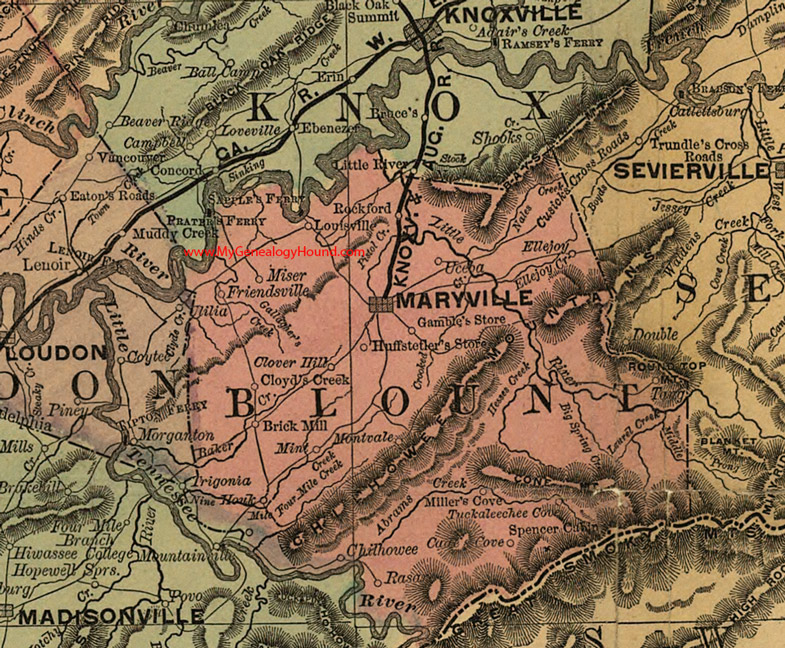 |
| An 1888 map, after Loudon Co. was formed, shows Four Mile Creek rising southwest of Montvale and running along the north foot of Chilowee Mtn. Farther north and west is Baker Creek, which runs from just outside Maryville southwest to Morganton, where it empties into the Little Tennessee. |
John H. was the son of John C. Hammontree and Mary (Patty) Murray. His grandfather James Hammontree had fought in the War of 1812 under Andrew Jackson (and with Sam Houston) at Horseshoe Bend (2nd Regiment, East Tennessee Militia). Two great-uncles of that James had been at Valley Forge: Pvt. Harris[on] Hammontree (1st Virginia, Continental Line) and Pvt. John Hammontree (10th Virginia, Continental Line), who died there.
But let us follow the course of John H. Hammontree in the Civil War. The central theater and its battles and generals may not be as familiar to Patient Reader as are those of the East. The air does not echo to the names of Buell or Bragg or Rosecrans. Hence, some exploratory reading has delayed this report.
Onward!
In 1860, on the verge of the Civil War, John was 19 and lived in the 2nd District, Morganton PO, Blount Co., Tenn. (1860 Census, R017-21). His father is listed as a distiller. The first of TOF's readers who remarks about hillbilly moonshiners gets a-whupped acrossen his pie-hole with the Salmon of Correction.
Although a quarter of Tennessee's population were slaves, the ridges, valleys, and mountains of East Tennessee allowed only small farms. Neither large row crops nor a plantation economy were possible. Therefore, only 1 in 12 persons was a slave.
On the other hand, in Middle Tennessee, large scale agriculture was important to the economy and 1 in 3 persons was a slave. West Tennessee, where the terrain flattens out, is well suited to growing long rows of crops. Here, plantations covered hundreds of acres, and 3 or 4 of every 5 persons was a slave!
 |
| The regions of Tennessee |
Tennessee was the last state to declare for secession. On the same day that Mississippi left the Union (Feb 9 1861), the voters of Tennessee voted 80 percent against secession. Fervor for secession tracked slave-holding. The West was avid; the East was agin it. Middle Tennessee was reluctant -- until Lincoln called for troops. Even so, when the state legislature finally voted for secession on 6 May, 32% of the House and 16% of the Senate still voted No.
East Tennessee promptly petitioned the legislature to secede from Tennessee and remain in the Union! But this was denied. Secessionists did not allow secession. East Tennessee unionist Andrew Johnson was the only Southern senator to remain in the Congress.
In October 1861, a pro-Union revolt broke out in East Tennessee. Gen. Thomas (in KY) prepared to march in support, but Gen. Sherman stopped him, whereupon the revolt collapsed and Union sympathizers were hanged from railroad bridges. Consequently, the nation missed its big chance to have a State with "East" in its name, but was treated to the curious spectacle of Confederate soldiers calling Tennessee Union soldiers "Rebs." War Secretary Cameron called Sherman "crazy" and fired him, putting Don Carlos Buell in charge of the Department of the Ohio. This turned out to be not the greatest idea the War Dept. ever had, as Buell was afflicted with more lassitude than a Megatherid Ground Sloth. Later, both Thomas and Sherman would go on to achieve considerable fame.
 |
| Gen. Don Carlos Buell planning lightning attacks. |
It was in this context that Kirby Smith's Confederate army occupied Knoxville in the spring of 1862 and set about gathering up all them eager soldiers they imagined to live there. Recruiters appeared in Morganton and told the Hammontree men that they must either join the Southern army or be taken away in chains.
Them's fightin' words to Tennessee hill folk. Ten Hammontrees, the sons of three brothers (James, Jeremiah, and John) and of a cousin (Philip) did the manly thing and slipped off to Camp Pine Knot, Kentucky, probably guided by another Blount Countian, Frederick DeBow Fulkerson
Fulkerson had enlisted in Co. H 5th Regt. Tenn. Vols. Inft. on 25 Feb. 1862. About 1 March, he was detailed by James T. Shelley, Col. Comdg., 5th Tenn. Inft. as recruiting officer to proceed to East Tenn. and pilot Union men to the U.S.A. and enlist them in the same. While in this service he was greatly exposed. While within the enemy lines he could travel only by night and lay consealed in some secluded forest through the day. Often being forced to wade and swim rivers and creeks and lay in his place on consealment went through the day in his wet clothing without the benefit of a fire to dry them. He made several of these trips into East Tenn. during the year 1862 (the year the conscript law was so vigorously enforced). At one time over seven hundred Union men crossed the Cumberland mountain with him many of them stil living to testafy to the exposure and harships they had to undergo. [all sic]
-- Declaration for an invalid pension 1November, 1869
On 21 May 1862 the Hammontrees were mustered into Fulkerson's Company H, 5th East Tennessee Volunteer Infantry for a three-year service. Their colonel was the aforesaid James T. Shelley, and they were brigaded under James G. Spears, a slave-owning Unionist (!) who desired above all things to exterminate Confederate sympathizers. Well, it takes all kinds. Spears' brigade consisted of the 3rd, 4th, 5th, and 6th Tennessee Volunteer Infantry, and these four regiments remained together for much of the war.
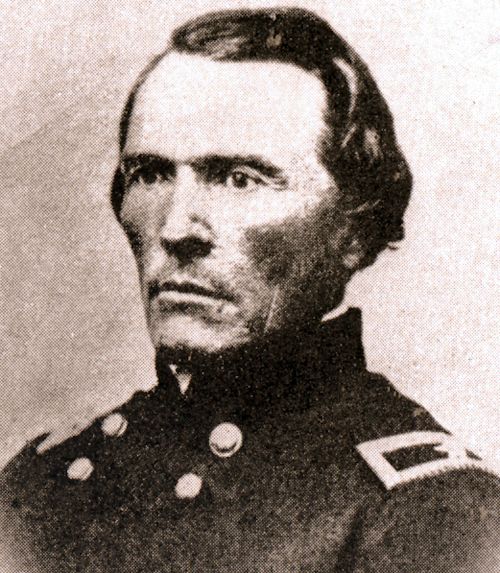 |
| Brigadier General James Gallant Spears
commanding 25th Brigade, 7th Division, Army of the Ohio -- 3rd Tennessee, 4th Tennessee, 5th Tennessee, 6th Tennessee Don't mess with him. |
The Cumberland Gap Campaign
 |
| Big Creek Gap, not in 1862 |
On June 11-12, Spear's Brigade clears the blockade on Big Creek Gap, opening the way to the Cumberland Gap. Known as the "Keystone of the Confederacy,” this pass provides one of the only natural openings through the Cumberland Mountains, making it prime terrain during the Civil War. Whichever side controls Big Creek could outflank and "starve out" any forces entrenched atop Cumberland Gap.
As Stevenson's Confederates evacuate on June 18, Morgan's division moves in and occupies Cumberland Gap, with no casualties. Morgan then successfully fortifies the gap with his four brigades of infantry, augmented by artillery placed on the heights. He calls the Gap "the American Gibraltar." During this time, "Colonel De Courcy and Captain Joseph Edgar were detailed as instructors of tactics for the officers of the new regiments of east Tennessee troops, who were brave, ambitious men and anxious to learn."
On July 16, the 3rd, 5th and 6th Tennessee Regiments surprise four companies of McLin's Tennessee Cavalry at Wallace's Cross Roads, 18 miles north of Knoxville and capture all their baggage and equipment, with four or five men. (All of the dispatches, orders, and subsequent testimony on the Cumberland Gap Campaign can be found here if one searches on "Spears" and then noodles around.)
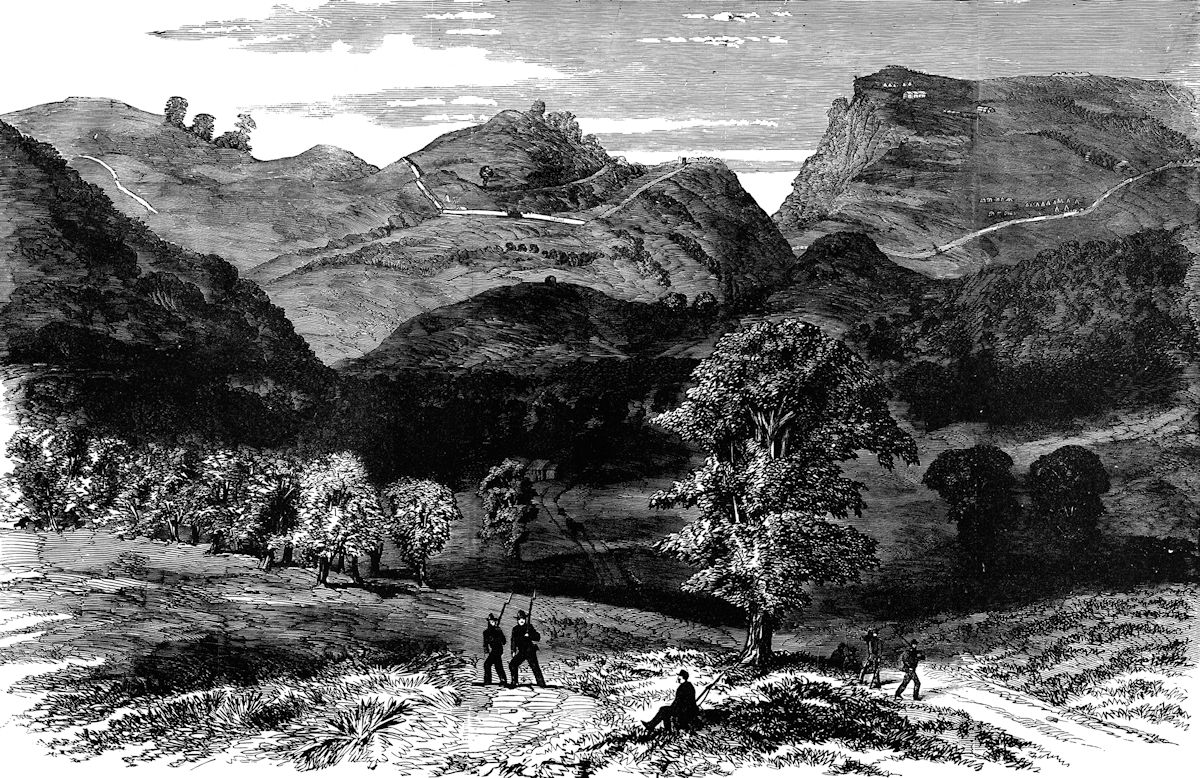 |
| Cumberland Gap manned by Union Soldiers -- Frank Leslie, Famous Leaders and Battle Scenes of the Civil War, 1896. |
- "Paroled at Knoxville, Tenn., July 21, 1862."
- "Parold & Exchd at Tazewell, Tenn. & Cumbd Gap, Sept. 5/62"
Does this mean he was taken prisoner twice? Neither army was equipped to maintain prisoners at the time, and so they agreed to turn them over to their own forces ASAP, with the promise that they would not take up arms until legally exchanged, soldier for soldier, officer for officer, and presumably tooth for tooth. This exchange might take place locally and immediately, or (later in the war, when larger numbers were involved) through some central arrangement. (All Union prisoners were then sent to Camp Parole, MD to await exchange, then went back to their units.) Hence, John may have been physically returned on "parole" in July, then legally "exchanged" in Sept., even if he was not physically in Confederate custody. Conversely, he might have been nabbed twice, in July and again in Sept., there having been clashes on both occasions. This system fell apart when the Confederates began putting their people back in the line without waiting for an official exchange. Thereafter, prisoners were kept in POW camps and, after the Confederates refused to include Negro soldiers in the arrangements, the camps never emptied and Andersonville resulted.On Sept. 1, an expedition is sent to Big Creek Gap that "killed and captured all but two of a rebel cavalry company of 112 men, passing safely through the lines of the enemy then enveloping the Gap." But there are also numerous small encounters between pickets.
An account of the battle of Tazewell involving other regiments in Morgan's command (August 1862) ends with this comment:
- "...in a couple of weeks an exchange was affected [sic] and the boys were all back, save Capt. Edgar who undertook to run the gauntlet and to get out, and was shot through the head and instantly killed."
In August, Braxton Bragg and Kirby Smith, imagining flocks of recruits swelling their ranks, determine on a joint invasion to "recover" Kentucky under the delusion that Kentuckians are jest a-rarin' to jine up with the Confederacy. Kirby Smith leaves Knoxville on Aug. 14, cutting off Morgan's supply lines. The 5th Tennessee participates in expeditions to Pine Mountain (Sept. 6-10) and again to Big Creek Gap (Sept. 7), but by Sept. 17 is forced to retreat with the rest of Morgan's command, which are facing starvation if they stay. [Depending on how we read the POW Memorandum, John was exchanged at Tazewell just before these actions.]
Morgan consults with his Kentucky engineers and traces out on a map the "Red Chalk Line," what we might call "the road less taken." It was less taken because it weren't no road 't all. It is rough going through wild country, but members of the command know every mile of it. Blowing up what they cannot take with them, they set off with Spears' Brigade leading the way. They appear at unexpected points from unexpected directions, often surprising the very Confederate patrols hunting for them, some with their suppers a-cooking. They confiscate cattle from pockets of rebel sympathizers and drive them along the way. A retreat and a cattle drive!
At one point Spears wants to summarily execute some captured civilians with secessionist sympathies, but General Morgan countermands the order.Morgan conducts a masterful retreat in the face of a much superior enemy force, and constant attacks from Col. John H. Morgan's cavalry. (A battle of Morgan v. Morgan!) In sixteen days, George Morgan's 8,000 men, including John Hammontree, marched over 200 miles from Cumberland Gap to Greenupburg, Kentucky, arriving there on October 3 with a loss of only eighty men. From there, they passed on to Camp Dennison in Ohio. Various accounts of the action can be found here, including that by Gen. Morgan.
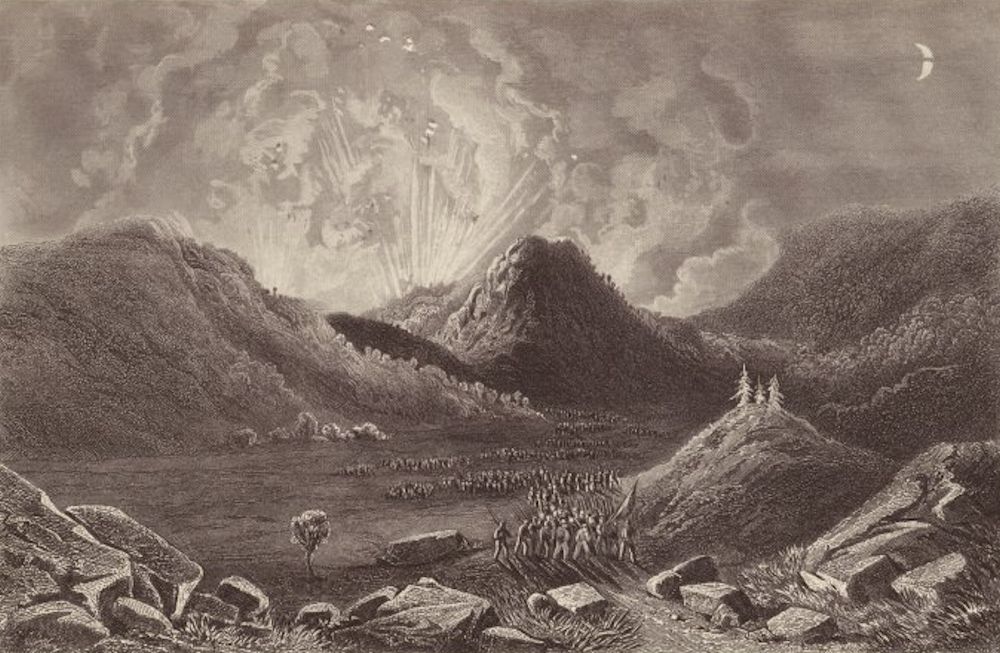 |
| As he retreats from Cumberland Gap, Gen Morgan detonates all the powder his men cannot carry with them |
The advances of Kirby Smith and Braxton Bragg that popped Morgan's 7th division out of "the American Gibraltar" like a pip from an orange was part of a Confederate effort to "reclaim" Kentucky (which had never seceded in the first place). Buell and Bragg race for Chattanooga, a race of the tortoise and... another tortoise. Bragg gets there first and Buell falls back on Nashville, then to his supply base at Bowling Green. Too weak to attack Buell directly, Bragg decided to wait him out.
But you can't out-wait a ground sloth.
Sept. 25 to Oct. 1, Buell shoots out of Bowling Green and into Louisville like champagne from an uncorked bottle! Bragg blinks and says, "Where is the real Don Carlos Buell, and what have you done with him?" Kirby Smith, who should have linked up with Bragg, is off chasing Morgan's single division and John Hammontree through the wilds of eastern Tennessee and Kentucky.
Bragg and Buell tussle at Perryville, except Bragg had gone off to inaugurate a "Confederate governor of Kentucky"! Everybody retreats. Buell's Army of the Ohio winds up at Nashville.
Finally, after Lincoln pokes Buell with a stick several times to see if he will move, Buell replies that he is "refitting" the Army of the Ohio. Exasperated, Lincoln replaces him with William Starke Rosecrans, who had been successful at Corinth under Grant. As a devout Catholic, "Ol' Rosie carries a crucifix on his watch chain and a rosary in his pocket, and he delights in keeping his staff up half the night debating religious doctrine. Rosie arrives, in Nashville, looks things over, and decides... the army needs refitting.Everybody retreats. Common in the early years of the war. There were many generals who favored a "soft war." They were fighting their friends and classmates from West Point, or their neighbors and did not press their advantages. The terrible bloodbaths are coming a little later.
Washington says, Uhh, that's why we replaced Buell, and Rosie replies, Don't rush me. Or in the lengthier 19th century fashion: "I need no other stimulus to make me do my duty than the knowledge of what it is. To threats of removal or the like I must be permitted to say that I am insensible." (Buell may have been slow, but he was no fool, to be rushed unready into battle by idiot politicians, the way McDowell had been rushed into Bull Run. Neither was Rosecrans.)
The Stone's River Campaign
 |
| XIV Corps flag, 2nd Div. |
On November 13, Fifth Tennessee is ordered with the other Tennessee regiments to Louisville, thence via Cincinnati and Bowling Green to Nashville. From Louisville, General Spears, reports on November 17 to General Rosecrans: "I am here with the residue of my command, the 5th Tennessee, and the 1st and 2nd Tennessee Cavalry." On December 4, part of the 5th is reported as still at Louisville, awaiting transport.
- Company Muster Rolls list John as "present" for Sept. 1 to Dec. 31, 1862.
XIV Corps, the operational equivalent of an Army, was
organized into three "wings" which were the operational equivalent of
corps. Fifth Tenn.
is listed in the order of battle in 1st Brigade (Spears), 2nd Division (Negley), Centre Wing (Thomas). When Ol' Rosie marches out of Nashville on 26 Dec to meet Bragg at Murfreesboro, he leaves Negley behind to garrison Nashville. Negley arranges to guard the supply lines and the wagon train and leaves Spears' brigade (incl. the Fifth) behind and arrives before Murfreesboro on the afternoon of the 29th, where he plays a pivotal role in the subsequent Battle of Stone's River, (Dec. 31 - Jan. 2, 1863).
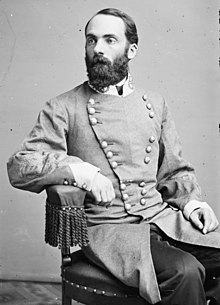 |
| "Fighting Joe" Wheeler |
At Stone's River, Spears (and the 5th) take position on the right, relieving Rousseau. Wheeler promptly notifies Bragg of the arrival of Spears' reinforcement and, hearing that John Hammontree had arrived on the scene, Bragg turns and runs.
Ho ho. TOF jests. It was the long casualty list (25% of his force), the threat of a rising river, and the unlikelihood that Rosie was going away any time soon that was persuasive. But the resupply, ammunition, and fresh brigade that came along with John was the final straw.
Meanwhile, the Army of the Cumberland is in no great shape, either, and Rosie does not pursue Bragg as modern historians grumble he should have. For them, these regiments are squares on the map, but to Rosie they are human beings -- which is why he was beloved by his troops. After the battle, Rosie said, "Bragg's a good dog, but Hold Fast's a better."
 |
| After escaping Cumberland Gap, the 5th was sent down to take part in the Stone's River Campaign |
Stone's River is the bloodiest battle of the war, surpassing event Shiloh and Antietam. The generals have not yet learned that, with the arms now available, even moderately well entrenched defenders can inflict terrible losses on attackers. But Rosie's victory secures Nashville as a Union supply base for the rest of the war.
In January, the Left-Centre-Right system is dropped and XIV Corps is split into three corps. Fifth Tenn. remained attached to 1 Bgde, 2nd Div., XIV Corps.
In January, the Left-Centre-Right system is dropped and XIV Corps is split into three corps. Fifth Tenn. remained attached to 1 Bgde, 2nd Div., XIV Corps.
- Company Muster Rolls list John as "present" for Jan and Feb, 1863.
Some of this shifting among divisions and such amounts to bookkeeping, placing the regiment under the nearest geographical command. The unit of the army in those days was the regiment.
The Tullahoma/Chickmauga Campaign
By the spring of 1863, a number of officers under Spears have grown tired
of his "tyranny and ungentlemanly conduct," and accuse him of
incompetence. Spears is court-martialed, and on June 8, 1863, the 3rd, 5th and 6th East Tennessee Regiments are placed in the 3rd Brigade, 3rd Division of General Gordon Granger's Reserve Corps, Army of the Cumberland, under the temporary command of General George Crook. The 5th remains on duty at Carthage, Tenn. until
August, employed in drilling and scouting around Carthage, Alexandria and McMinnville.
- Company Muster Rolls for Feb 28 to June 30, 1863, list John as "present." Those from June 30 to Oct. 31 do not state his status.
On August 31, Brigadier General Spears resumes command of the
brigade, with headquarters at Alexandria, Tenn. Granger orders Colonel Shelley (5th Tenn) to move his command to
McMinnville. Shelley (at this time in temporary command of additional regiments and units) leaves the Fifth, temporarily under Lieutenant Colonel
McCaleb, at Carthage.
 |
| After Stone's River, the 5th was posted at Carthage TN. Then was sent to Chattanooga in time to cover the retreat from Chickamauga |
On September 2, the 3rd, 5th and 6th Tenn., all under operational command of Colonel Shelley, move to McMinnville, where they are joined a little later by General Spears, with the rest of the brigade. Leaving two companies of the 5th Tennessee at Carthage [Which two? Who knows?] the brigade leaves McMinnville and about Sept. 10, crosses Cumberland Mountains at Beersheba Springs to Jasper. The brigade then moves to the Tennessee River at the mouth of Battle Creek. Crossing the river here, it moves to Chattanooga via the Sequatchie Valley, arriving September 21, just after the Battle of Chickamauga has put the kabosh on Rosecrans' brilliantly executed Tullahoma Campaign.
While the rest of Granger's Reserve Corps help shore up Thomas' defense on the battlefield, the Tennessee brigade is stationed at the bridge over Chickamauga Creek at Shallow Ford Gap to halt and reform the Federal troops streaming into Chattanooga. They have instructions to stop all Federal soldiers below the rank of major general. Presumably, major generals can keep running.
Three companies from the 5th are placed on the river along the railroad. The remaining five companies of the 5th are placed in line of battle at the crossroads, on the point of Lookout Mountain on the south side. [TOF does not know in which group Johm's Co. H was.] About noon on the 22nd, according to an after-action report by Gen. Spears [scroll down at link], they are attacked by Confederate forces, and after an engagement of about an hour and a half, fall back to a more favorable position on the first bench of the point of the mountain. They remain here until early in the morning, September 24, when the whole brigade withdraws into Chattanooga. The Confederates move onto Lookout Mountain and Missionary Ridge. The Siege of Chattanooga has begun.
Civil War Irony: In the early 1800s a branch of the Hammontrees had migrated from Blount Co. to Georgia and at least one of them, William, is in the opposing Confederate army. TOF thinks they are second cousins.
Ol Rosie's Army of the Cumberland is now bottled up in Chattanooga (a thriving metropolis of over 2,000 people back then) under siege by Bragg's Army of Tennessee. Confederate general "Fighting Joe" Wheeler raids the supply lines. When rain begins to fall in October, washing out the only supply road, things get critical. Rosecrans had made one mistake at Chickamagua: he had ordered a division to fill a gap that wasn't there and in the process opened a real one -- which Longstreet (on loan from Lee) exploited to the full. Afterward, Lincoln says that Rosecrans seemed "confused and stunned like a duck hit on the head," which proves that one awshit cancels out a dozen attaboys. His second mistake was to flee the battlefield with one-third of his army while Thomas rallied the other two-thirds and held off the Confederates long enough to permit an orderly withdrawal into Chattanooga.
 |
| Chattanooga in 1863, under siege. |
 |
| 3rd Division, XIV Corps |
Meanwhile, Burnside has liberated Knoxville, to the cheers and celebration of its inhabitants and is liable to come down and reinforce Chattanooga. This makes Bragg nervous.
Civil War Note: Both Burnside and Hooker had previously commanded the Army of the Potomac with Fredericksburg and Chancellorsville to show for it. But as corps commanders they were actually pretty good. Otherwise, "Hi, we're Burnside and Hooker, and we're here to help" would not sound especially encouraging.
For the remainder of the year, Spears' brigade, including the 5th Tenn., is stationed at Sale Creek Academy 28 miles above Chattanooga on the north side of the Tennessee, guarding Blythe's Ferry and other crossing points. They skirmish with the enemy on the south bank of the river almost daily.
The Knoxville Campaign
Early in November, Bragg orders Longstreet to march against Burnside in East Tennessee. This causes great pearl-clutching in Washington, which urges Grant to act promptly to assist Burnside. Thomas thinks the best way to help Burnside is to defeat Bragg, who is now short a corps. Burnside thinks he can hold out and believes he can help Chattanooga best by tying down Longstreet's corps away from the main action. |
| Second Division, XXIII Corps, Army of the Cumberland |
Longstreet marches without maps and logistical supports from Bragg, and without the manpower he had asked for. Consequently, his campaign is one of improvisation. He hopes to cross the Little Tennessee at Morganton en route from Chattanooga to Knoxville, as he later recalls:
Had the means been at hand for making proper moves I should have marched for the rear of Knoxville via Morganton and Marysville...
But he lacks the materials to construct a pontoon bridge, and is forced to cross the Tennessee at Louden, and approach from the west.
You might note that he is marching through Hammontree home territory.
Burnside had earlier moved south out of Knoxville to link up with Thomas (and do some recruiting in western North Carolina, another Unionist stronghold) and his advance units had reached Cleveland (TN) before Chickamauga turned the whole maneuver into a Really Bad Idea. Now he pulls back within his forts barely in time to avoid being cut off by Longstreet. He has enough supplies to hold out for a while, but after that must withdraw or surrender. The locals solve his problem by piling up rafts with supplies and floating them down the Tennessee river to be snared by nets across the stream!Meanwhile, help is a-coming, in the form of John Hammontree and his buddies, who reach Kingston on 3 December. With one hitch, as we shall see shortly. Spears reports:
 |
| When Longstreet invades Blount, John and apparently others went AWOL to see to their families. |
Headquarters United States Forces
Near Loudon Tenn December 6 1863
General: In obedience to orders from Major-General Granger, I arrived with my command at Kingston on the evening of the 3d instant. A dispatch from you [Maj.-Gen. Sherman] was handed me in an hour or so after my arrival, in which the senior officer at Kingston was directed to collect the forces at Kingston, and on the appearance of the steamer Paint Rock, then coming up the river, to move forward with the forces, the right flank to rest on the river, a small force to be left at Kingston as a garrison.
I being the senior officer commanding First Tennessee Brigade, assumed command of all the forces there, consisting, in addition to the Tennessee Brigade, of the First Brigade, Second Division, Twenty third Army Corps, Colonel Mott (four regiments), and the First Tennessee Mounted Infantry, Colonel Byrd, together with battalion Third Indiana Cavalry, Lieutenant-Colonel Klein, and eight pieces of artillery attached to my brigade, and nine pieces artillery attached to Colonel Mott's brigade, in all, eight regiments of infantry (one mounted), battalion cavalry, and seventeen pieces artillery.
I moved forward with all of the above forces, excepting Colonel Byrd and his regiment, then on picket duty on the river, whom I left at Kingston with orders to draw in his force and to aid and assist in getting the steamer up from off White Creek Shoals, where I was informed by Lieutenant-Colonel Remick, chief commissary subsistence, that she was aground. I sent two experienced pilots, well acquainted with the river and channel, etc. etc.
-- Reports of Brig Gen James G Spears US Army commanding First East Tennessee Brigade
Civil War Irony: The divisional commander over Spears and the Tennesseans was Gen. Jefferson C. Davis. Gosh, he must've got kidded a lot.Meanwhile, the rest of the army, reinforced by Hooker's two corps, has broken the siege of Chattanooga and sends Bragg reeling off Missionary Ridge, leaving Longstreet's corps hanging in the air.
On December 3, the 5th Tenn., with the rest of the Brigade, is at Kingston, Tennessee; on December 6, at Loudon; on January 1, 1864, at Massengale House, near the Holston River, 30 miles northeast of Knoxville; on January 16 at Flat Creek Bridge. It was during this time the muster rolls show our John as "absent without leave" (Nov. and Dec. 1863) and then in Jan. and Feb. as "under arrest from Jan. 4, 1864."
So where was John Hammontree during this time if not engaged in the many skirmishes recorded in The War of the Rebellion: A Compilation of the Official Records of the Union and Confederate Armies? It seems that John went AWOL (along with Hiram Hammontree, and who knows who else) round about the same time Longstreet and the whole Confederate Army of East Tennessee was proposing to cross the Little Tennessee into Blount County, right about where the Hammontrees had left their farms and families. Under such circumstances, it is likely that they went home to see to the safety of their people. Once the Confederates had left Blount County, John evidently returned to the Fifth, since he is present and under arrest in the Jan-Feb muster rolls.
One doubts the Union armies were so well coordinated as to do things in strict bimonthly intervals, so we suppose the entries on the muster rolls mean that these things happened at some time during those months, not that he was AWOL for two months or under arrest for two months. Although, who knows? He may have been.
The Atlanta Campaign
On February 1, 1864, 5th Tennessee was detached and ordered to garrison Loudon, close to home. The commander of the Tennessee Brigade, James Spears, though a staunch Unionist, is also a slave-holder and has opposed Lincoln's
Emancipation Proclamation. He
has allegedly stated, "God damn the Government; let her go to hell, and I'll
be found in the ranks fighting her."
He is arrested for these statements in February 1864, and subsequently
court-martialed. While Spears admits he disagreed with the
Proclamation, he denies making disloyal statements. He is nevertheless
found guilty, and ordered removed from command. Offered an
opportunity to resign his commission, he refuses, and is dismissed the service on August 30, 1864. (Wikipedia)
 |
| 3rd Division, XXIII Corps |
Sherman, commanding the Division of the Mississippi fields three armies in this campaign:
- Army of the Cumberland (Thomas) 61,000
- Army of the Tennessee (McPherson) 24,000
- Army of the Ohio (Schofield) 13,500
 |
| Gen. Blowhard Schofield |
Schofield is unique in US Military history. When he is interim Secretary of War (1868-69), he will recommend and award to himself a Medal of Honor for his actions at Wilson's Creek. His main military objective seems to have been subverting fellow general George Thomas, the only general to have written no self-serving memoirs. Even so, all three of Sherman's generals are competent
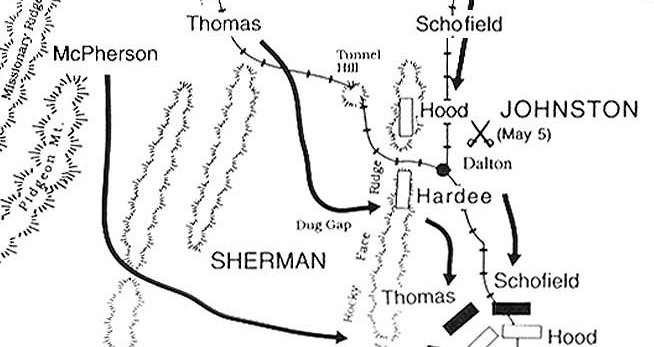 |
| Attack on Rocky Face Ridge. John is in Schofield's army |
Schofield's Army of the Ohio and John Hammontree engage the enemy at Buzzard Roost (Mill Creek Gap). On 9 May, McPherson finds the Confederates entrenched on the outskirts of Resaca. Fearing the strength of the enemy, McPherson pulls his column back to Snake Creek Gap, tworking off Sherman, who had hoped to trap Johnston. But Johnston, hearing that the Hammontrees are on the field, leaves his entrenchments and retreats.
On 14 May, a major battle erupts at Resaca, Ga. Regarding the battle, General Cox reports that:
 |
| John H. Hammontree can be found just above Schofield's name on the left. Look for COX, then for the small print for MANSON. The 5th Tenn. is part of the first line of Manson's Second Brigade. |
"The skirmish line of the division already occupied the edge of the wooded land across the open valley, some 200 yards wide, immediately in our front, when the command to advance was given and the whole division moved steadily forward, the enemy opening immediately with artillery from batteries in position down the valley on our right, and which had an oblique fire upon our lines as we passed through the low ground. After crossing the open we passed over several wooded ridges in succession, and through a deep though narrow channel of the creek, which, with its perpendicular sides, skirted by a tangled thicket, became a serious obstacle to the advancing troops. The lines were quickly reformed after passing the brook and again moved forward, steadily driving the enemy's skirmishers backward toward their works. These skirmishers were so strongly re-enforced that they were only to be driven back by the main line of our troops, who advanced, making an occasional momentary halt to deliver their fire. A short halt was made, bayonets were fixed, and the whole command charged the hill and carried the line of rifle-pits on the crest, driving the enemy back upon a second line some 250 yards from the first on our left, but approaching much nearer on our right. The first line of the Second Brigade was first in entering the works, but these were almost instantly entered by the First Brigade also farther to the left. The enemy immediately opened with both artillery and musketry from their second line, which extended far beyond both flanks of the division, and no troops being as yet in position on either our right or left, the division was halted, the Second Brigade (Manson's) occupying the enemy's works with their first line, and the First Brigade (Reilly's) occupying them with the second line, advancing the first line to the protection of a small intervening ridge between them and the new line occupied by the rebels, from which they were able to silence with their rifles a battery which was playing destructively upon the Second Brigade. No artillery had been able to accompany the division in its advance to attack, the broken nature of the ground and the physical obstacles of the creeks and thickets entirely preventing. The continuous heavy fire of the enemy caused, however, a considerable loss in both the One hundred and third Ohio and Fifth Tennessee while advancing to their position. An hour later I reported the ammunition of the whole division as being almost exhausted, and it being impossible to get wagons forward to the lines held by the command, I was notified that we would be relieved by the Fourth Corps and withdrawn temporarily to enable us to replenish the cartridge-boxes. A little after 3 p. m. General Harker's brigade, of Stanley's division, Fourth Corps, advanced under a galling fire of all arms to relieve the Second Brigade, and while preparing to effect the change Brigadier-General Manson was severely injured by concussion of a shell exploding near him, and was carried off the field." (OR No. 351)
 |
| From Loudon to Chattanooga, thence to Resaca. Wounded, John is e-vacked to Chattanooga, Nashville, and New Albany |
In his Application for an Invalid Pension, John will later attest that he was treated first in hospital at Resaca for 2(?) days, then in hospital at Chattanooga for a few days, at Nashville, then at New Albany, Indiana, "in the summer of 1864." Why he was moved around so much TOF does not know. Maybe that was normal, since Capt. Fulkerson, also wounded at Resaca (in the right leg, breaking the bone) was similarly shuffled about.
On June 22, Alexander Hammontree (a cousin of John) writes to his father James (spelling sic):
Dear father I seat myself this Morning to let you know that I am well Harvy is well we are camped on the old fedral Rode 5 miles from the river Chattahoocha about 17 miles from atlanta & are a going on that way we have been fiting And driving the rebs all the time since we have been in gorgia ther has bin som hard fiting there was hard fiting on the line yesterday a bout 1 mile from us our core was not ingaged in it we was ingaged in some hard scurmishing for a while ther is some fiting on the line this morning I expect this will be a blody day with us so the boys are all well that is her except unkle Johns James he is not well tho not so bad as reporting to the doctor We have not heard from John since he was wonded tho he is beter I sopose philips Jim has gone to Cattenooga horspitel you herd he was wonded unkle Jerys boys are all well Well we get a nuf eat wear and are doing well in the Wildernes of gorgia this is a desetet country the sitozens all flees before our armey & leaves all they have they are bound to starve every thing is tore up the word left bare well I will not say any more this time I am well and harty harvy is as stout as you ever saw him I would like to see you all very well tho I do not expect to till my time is out rite son as you git this nomore at present Alexander Hammontree to his father James Hammontree I have not had a leter from hom yet good by
(Note: expressions like "unkle Johns James" and "philips Jim" were to distinguish Hammontrees of the same name. There was also more than one John)Colonel Shelley resigns as commander of the 5th on 22 July to take command of a mounted regiment, and Major Bowers is in command from that time until after the battle of Nashville.
Muster rolls for July and August report John Hammontree being "in the hospital" due to the wound received at Resaca, while those for Sept and Oct report him as Present, so we may assume that he has rejoined the Regiment by Sept.
In the meantime, Sherman says, "Atlanta is ours and fairly won."
The Nashville Campaign
On August 11, 1864, in the field near Atlanta, the XXIII
Corps is again reorganized, the 1st Division discontinued, and the regiment
remains in the 3rd Brigade, 3rd Division. However, the Fifth is reported at
this time as detached at Marietta, Georgia. From Marietta, Thomas Harvey Hammontree writes to his sister Elizabeth on 3 Sept. 1864, twitting her on her choice of beau:
"I would like to now how you & them Mawsabacks [mossbacks] are agiting along I want you to tel him to put on his Shoos before he com back anymore I dont whant to com hom & see My brotherinlaw aruning about barfooted..."Apparently, there are folks even hillbillies look down on. T.H. also writes to Patrick Hammontree about the imminent election.
"I want you to write to me and tell me how you and them friends of yours and mine is going to voat in this presidenttial Election if you are for A.B. you are all Setting But Stand and Study All a bout Mcclellan Copper headism Bee fore you Say any thing for him... is you See Catherine tell her i aint maried yet..."Harvey Hammontree writes:
"I will tell you that wee are all for linkwin [Lincoln] as Jim Brooks Says and wee are in hope that you all will voat with ues if Tenn gits a voat a tall..."
 |
| 5 Tenn. is on right of map straight below where it reads "COX" and "REILLY". |
- By Sept/Oct., John Hammontree is again listed as "Present" in the muster rolls of the Fifth.
Pres. Davis replaces Johnston, who has run a brilliant series of retreats during the Atlanta campaign, largely because he doesn't like the word "retreat," brilliant or not. He wants an aggressive general.
Be careful what you wish for.
John Bell Hood knows only one strategy: attack. He invades Tennessee hoping to pull Sherman from Atlanta by disrupting his supply lines. Sherman ignores him and peels of two of this three armies to smack Hood while he pulls a Grant, abandons his supply lines, and Marches to the Sea.
The 5th Tennessee arrives at Nashville on 15 November, and is sent to join Major General John M. Schofield at Pulaski. With Schofield, the Fifth leaves Pulaski on 22 November, withdraws through Columbia and Spring Hill, and arrives at Franklin on the morning of the 30th. In the (animated!) battle of Franklin, the 5th Regiment was in the second line of Colonel Casement's 2nd Brigade, between the Columbia and Lewisburg Pikes and barely moves during the battle. Major Bowers reports only six casualties.
Alexander Hammontree writes:
Camps near collumbia November 29 64
Midel tennessee
We have bin her 4 days & ar her yet we have bin fiting Some every day Since we have bin her no on hert in our compny but one man Wonded there has bin a good many kil since we com to this plaes... we was don the country severel miles forther at a ton by the naem of Pulaska & had to fall back & burn the ton up they ar fiting a bout one 1 miel from her now we ar in the reserv at this time we will whip them..."
Hood, who had attacked with everything he had, discovered that everything wasn't enough. The "Pickett's Charge of the West" puts even Burnside's tactics at Fredricksburg to shame. Nonetheless, Hood proceeds to Nashville, not knowing what other direction he might go. This is not a Good Idea.
Thomas, in overall command, Bides his Time and Makes Preparations. (The weather is bad.) This irritates Grant and panics Washington, where they would much prefer a Hood-like impetuosity. But Thomas is an overlooked gem of a commander. He is not slow, like Buell had been; he is methodical. There's a difference.
In the battle of Nashville, December 15-16, 1864, he earns his second nickname: "The Sledge of Nashville" when like Maxwell's Silver Hammer he comes down upon Hood's head, in consequence of which the Confederate Army of Tennessee ceases to be a coherent force.
The 5th Tenn. is not engaged on the 15th. On the 16th, it is in line of battle on the
Hillsboro Pike, and comes under musketry fire, but does no serious fighting, and
only one man is wounded.
- The muster rolls for Nov and Dec record John as "Present" and "Arrest." Presumably this arrest is an ongoing thing related to his earlier AWOL episode
After the battle, Maj.-Gen. Thomas does an amazing thing. He actually pursues Hood's forces, almost unheard of for a Union general. Hearing that John Hammontree is pursuing him, Hood flees to the Tennessee River, December 17–28.
On December 31, Lieutenant Colonel Nathaniel Witt is in
command of the 5th Tenn., still in the 2nd Brigade, 3rd Division, XXIII Corps.
After chasing Hood's remnants for a bit, the 5th Tenn. is sent to join Sherman, who is now Marching Through Carolina. The division moves to Washington. D. C. by boat and train. Alexander writes again:
After chasing Hood's remnants for a bit, the 5th Tenn. is sent to join Sherman, who is now Marching Through Carolina. The division moves to Washington. D. C. by boat and train. Alexander writes again:
February the 2: 1865Where they go "for Serten" is Fort Fisher, N. C., where they stay January 16-February 9. They arrive at Cape Fear February 8-9-10, 1865, and take part in the campaign which results in the occupation of Wilmington, on February 22, 1865.
Camps ner Washington Sitty
The State of Maryland
Dear Sister I seat myself this evening to rite yo a few lines... we landed her yesterday we was 16 days & nites on the rode we caem to Sincanata on the botes & on the Cars from ther to this plaes all got therens saef this far we are in camps now I kennot tel how long we will Stay her ther is som talk of going on soon... this is a nies place her & a very large sity... orders to be redy to leve her to night or in the morning we Crost the potomick River yesterday on a bridg it is a very larg stream we crost the James River [sic] at harpers ferry well our tiem will be out the 27 of this month they say her we will have to serv 2 or 3 months longer than our tiem if we do I will think very hard of it well ther is some talk of peas her now the Rebs want peas bad I dont know how they will find it... we are at anopelas now on the bay we are on a Ship now on the weigh to Richmon we got on this Ship last nit we ar weighting to leave evry minit wer we will go for Serten I kennot tel
- Muster rolls list John as "Present" for March and April.
Nashville, Tenn. April 23, 1865. "Sir, I respectfully ask thirty days furlough to visit my home in East Tennessee. I have the honor to be very respectfully your most obedient servant. John Hammontree, Pvt. Co.H, 5 TV Inf."TOF does not know if he got it. Probably not, since things are rolling to a close. How he can write the request in Nashville while being Present with the regiment in North Carolina is unclear. One possibility is that, as a three-year man enlisting on 21 May 1862, his discharge is immanent and along with other enlistees of that cohort, perhaps all of Company H, he has been moved to Nashville in preparation for mustering out. In any case, the war is drawing to a close:
- On April 26 Johnston surrenders his army at Bennett's House and whatever is left of the Fifth does occupation duty at Raleigh and Greensboro until June.
May 16, 1865. Nashville, Tenn. Muster Out Roll.
John H. Hammontree, Pvt. Co.H, 5th Regiment of Tennessee Infantry, aged 20 years. Mustered out same date. Last paid to August 31, 1864. "...was on original organization as private. Mustered out by reason of expiration of term of service."
Book mark: Restored to duty with loss of pay and allowances for the time he was absent without proper authority. He will make good to the service the time thus lost. Vide S.O. No.85, April 1, 1865.
After the War
31 January, 1867. He is "restored to duty" by the Adjutant General's Office in Washington, "with loss of all pay and allowances for the time lost to absence without proper authority." In a sense, he was forced to stay after school to make up his time.
17 April 1867. His first child, Harrison Burton Hammontree, ancestor of the Incomparable Marge, is born in Blount Co..
 Shortly after this the family hops in a covered wagon and sets out for the Indian Territory, winding up in Sebastian Co., Ark. in the township of Sugarloaf, in time for John to appear in the 1870 census. He is listed as a farmer, aged 28, with $800 real estate (=$14,545) and $115 personal property (=$2,091).
Shortly after this the family hops in a covered wagon and sets out for the Indian Territory, winding up in Sebastian Co., Ark. in the township of Sugarloaf, in time for John to appear in the 1870 census. He is listed as a farmer, aged 28, with $800 real estate (=$14,545) and $115 personal property (=$2,091).21 March 1874. John Hammontree applies for an invalid pension. In the application he claims to be 2/3 impaired in his ability to work his farm and that this is due to the wound he received at Resaca, which had never fully healed.
The 1880 Census lists his family still in Sugarloaf:
- John Hammontree 37 farmer
- Rosa H. (wife) 27 keeping house
- Harry B. (son) 13 farmer
- John C. (son) 9 at home
- Mary E. (dau) 8 at home
- Emma (dau) 2 at home
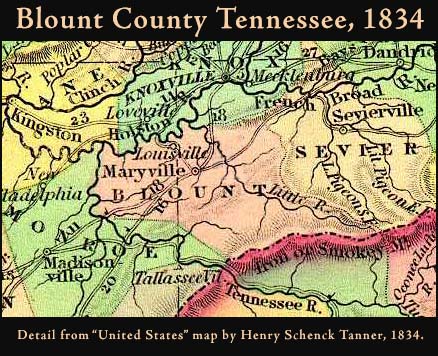



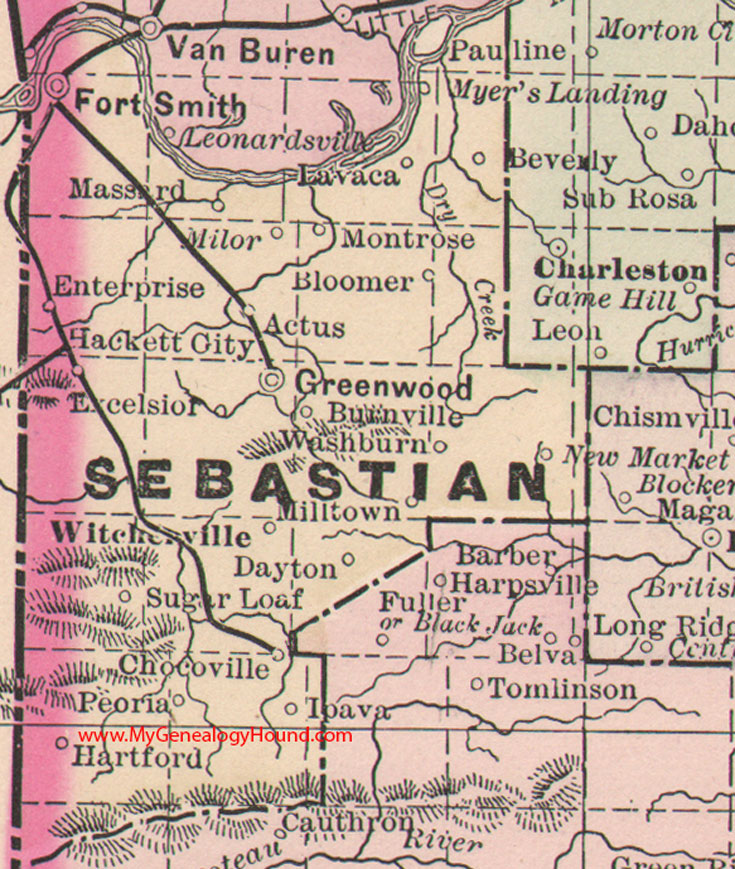


Your article has been cited and linked to under an article of mine in answer to Jack Hunter.
ReplyDeleteThat Priority is Not Mine
on New blog on the kid
nov9blogg9.blogspot.fr/2015/06/that-priority-is-not-mine.html
Thank you for this article. I've completed the genealogical process back far enough for SCV & SUVCW, and am interested in pursuing 1812 & SAR. Would you be willing to share your research sources?
ReplyDeleteDrop me a line at theofloinn@aol.com
DeleteI stumbled upon this blog while I was doing some research.
ReplyDeleteI am a 2nd great granddaughter of Louis Alexander "Alexander" Hammontree (1835–1912), who you quoted in this piece. Your John H. Hammontree was my first cousin, 4x removed. So you and I are cousins, too.
I will try to follow your blog and contact you.
Sincerely,
Your cousin,
J. Ross